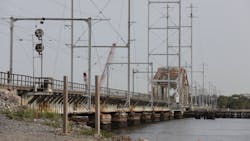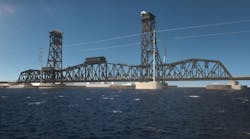Raritan River Bridge Replacement Project breaks ground
Officials broke ground on the Raritan River Bridge Replacement Project (River Draw) Sept. 15; the bridge replacement is one of the single largest Superstorm Sandy resiliency projects to be pursued following damage from the storm in October 2012.
The River Draw spans the Raritan River between South Amboy and Pert Amboy, N.J., and provides a rail link for New Jersey Transit (NJ Transit) North Jersey Coast Line (NJCL) trains and Conrail freight trains. For NJCL riders, the bridge provides the only rail link for 17 of the line’s 20 stations to major job centers in Newark, Jersey City and Manhattan.
“Smart infrastructure projects like this are at the heart of building a stronger, fairer and more resilient post-COVID New Jersey,” said New Jersey Gov. Phil Murphy. “To recapture our state’s mantle as the economic corridor to the nation, we need to ensure that we have the infrastructure in place to get residents to and from work, school or play. Importantly, this project will also provide an economic stimulus at just the right time and bring with it more than 5,700 good-paying jobs.”
The two-track bridge was built in 1908 and its approach girder spans were moved out of alignment by Superstorm Sandy’s ocean surge. The damage from the storm has resulted in recurring maintenance issues.
Earlier this year, NJ Transit Board of Directors approved a contract with George Harms Construction worth approximately $250 million for the initial construction phase of the River Draw replacement project.
A new two-track bridge will be built parallel and to the west of the existing bridge. The new structure will integrate resilient structural designs and materials to withstand future storm surges and be significantly less vulnerable to severe weather events.
“The new lift span bridge over the Raritan River will sit higher above the water and is a more reliable design than the existing swing bridge that was built in 1908,” said New Jersey Department of Transportation Commissioner and NJ Transit Chair Diane Gutierrez-Scaccetti. “It will be able to weather storms better and require less maintenance, meaning more reliable service for the customers that take the North Jersey Coast Line between the Shore and Manhattan.”
The state says the western alignment would place the new bridge farther away from the ocean to improve flood resilience and increase the design speed for trains on the bridge. The introduction of new mechanical and electrical systems would also provide for more reliable span operations, resulting in reduced maintenance costs. In addition, improved navigation at the lift span will significantly reduce the risk of vessel collision with the bridge’s pier protection systems.
“This 112-year-old bridge is an essential rail link for communities all along NJ Transit’s North Jersey Coast Line, carrying approximately 11,000 daily customers and connecting them to major job centers in Newark, Jersey City and Manhattan,’’ said NJ Transit President and CEO Kevin Corbett. “The bridge was significantly damaged by Superstorm Sandy, which is why its replacement is critical, and why we will build it back stronger and more resilient than ever before. This is just one of many major, long-stalled capital projects now advancing through our recently introduced Five-Year Capital Plan.”
Nearly 75 percent of the estimated $595 million price tag for the project will be covered by a $446-million Federal Transit Administration grant awarded in 2014 through the emergency resiliency program.

Mischa Wanek-Libman | Group Editorial Director
Mischa Wanek-Libman is director of communications with Transdev North America. She has more than 20 years of experience working in the transportation industry covering construction projects, engineering challenges, transit and rail operations and best practices.
Wanek-Libman has held top editorial positions at freight rail and public transportation business-to-business publications including as editor-in-chief and editorial director of Mass Transit from 2018-2024. She has been recognized for editorial excellence through her individual work, as well as for collaborative content.
She is an active member of the American Public Transportation Association's Marketing and Communications Committee and served 14 years as a Board Observer on the National Railroad Construction and Maintenance Association (NRC) Board of Directors.
She is a graduate of Drake University in Des Moines, Iowa, where she earned a Bachelor of Arts degree in Journalism and Mass Communication.




